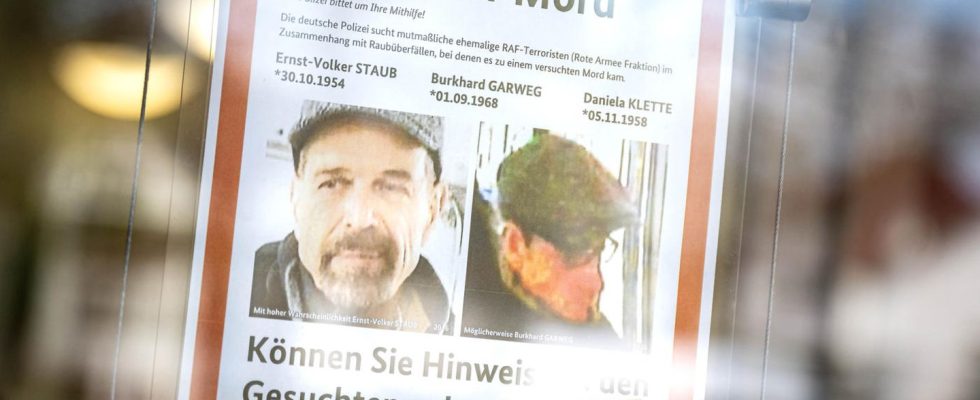Mysterious third generation
What is known about the last ex-RAF members – does Klette reveal it?
A wanted poster hangs at the Verden district court: The search for dust and cooking continues
© Sina Schuldt / DPA
After the arrest of Daniela Klette, two former RAF terrorists are still wanted. But the security authorities know little about Ernst-Volker Staub and Burkhard Garweg – as well as about the entire third generation of the RAF.
Klette is now in custody at an unknown location. It is unclear what their life was like underground. According to a neighbor, she lived under the first name Claudia. In order to earn money, she is said to have given private tutoring in mathematics, the neighbor said. It is said that she lived there on the 5th floor for around 20 years. He often talked to Klette, who used a different last name. But Klette only maintained rather superficial contacts with the neighborhood. “She always said hello and was actually quite nice,” said a young person from the neighborhood. “I only ever saw her alone with her dog and her bike.” Several residents said that Klette was never accompanied.
Your further behavior towards the judiciary is open. Of course, Klette is open to the legally regulated leniency program, says senior public prosecutor Clemens Eimter Bäumer. To do this, however, she would have to testify clearly beyond her own contribution to the crime – so Klette can only save herself from the threat of a long prison sentence if she unpacks everything.
The actions of the third generation are largely obscure
The public prosecutor’s office and the BKA probably have many questions. Who carried out the assassination attempt on Deutsche Bank boss Alfred Herrhausen in 1989 more than 30 years ago? Do Staub, Garweg or Klette know who was involved in the assassination attempt on Trust President Carsten Rohwedder in 1991? After all, the same rifle is said to have been used as in the attack on the US embassy in Bonn in the same year, in which Klette was involved. Who blew up the new prison in Weiterstadt in Hesse in 1993 before the RAF announced its dissolution in 1998? The BKA has identified traces of dust, Garweg and burdock. Two other people are said to have been involved.
Red Army Fraction
30 years of left-wing terror – the chronicle of the RAF in Germany
It is hard to hope that the pressing questions will be answered. The third generation of left-wing terrorists is largely a mystery to security authorities. It can be assumed that Klette, like most terrorists so far, will remain silent. “They won’t say anything. Everyone has remained silent so far, no one has betrayed the other,” an investigator predicted many years ago.
Accordingly, little is known about Klette’s comrades-in-arms, Staub and Garweg. Staub probably belonged to the command level of the third generation of the RAF. The Hamburg native was imprisoned for four years in the 1980s for membership in a terrorist organization. After his release, he went underground again and rejoined the RAF.
Dust and cooking paths are phantoms
These are the few traces of dust: His fingerprints were found on a letter that was found on Birgit Hogefeld, who was arrested in Bad Kleinen in 1993. Klette is said to have been Staub’s “friend” or “companion” at the time. Investigators believe that the two were there at the incident in Bad Kleinen. At that time, Hogefeld was arrested, the RAF terrorist Wolfgang Grams shot himself, seriously injured after the unsuccessful arrest. He had previously killed the GSG-9 officer Michael Newrzella. Another reference to Staub comes from a stylistic analysis of the RAF dissolution letter from 1998. Some formulations are said to have come from Staub.
Less is known about Garweg. He is said to have become radicalized in the Hamburg Hafenstrasse area at the end of the 1980s until he finally went underground. Since then there has been little evidence. Garweg was apparently involved in the attack in Weiterstadt, and his traces later appeared in connection with the robberies. Nothing more is publicly known.
Source: DPA

